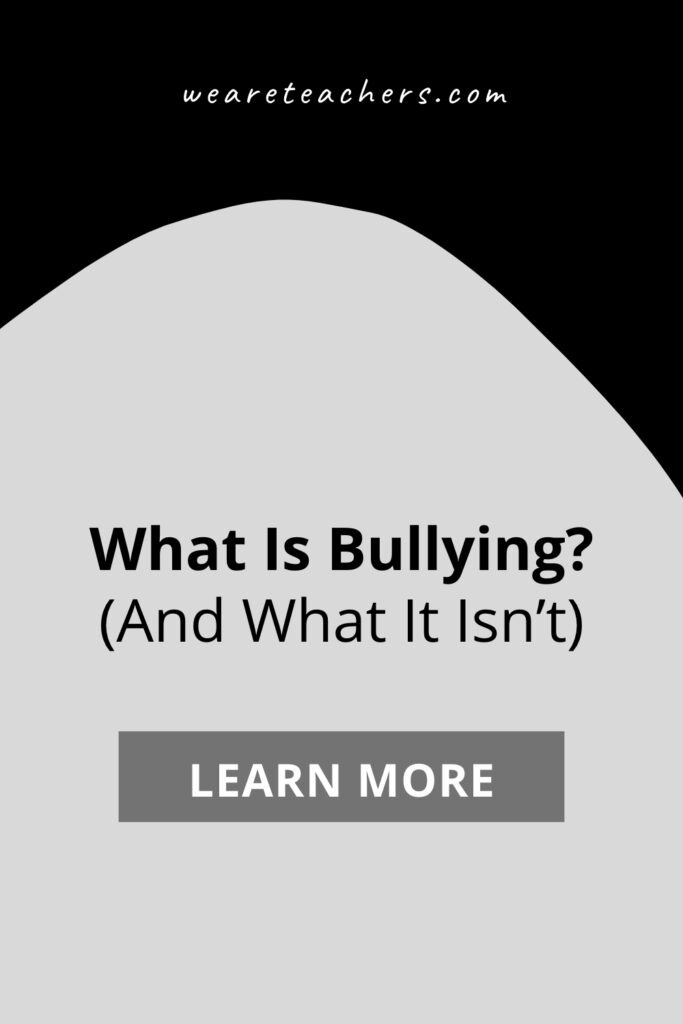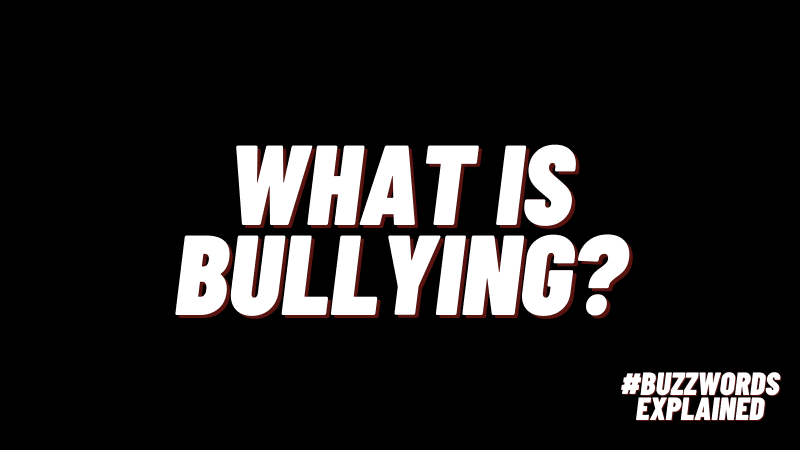A recent conversation in the WeAreTeachers Principal Life group on Facebook raised an important question: What is bullying, exactly? And just as importantly, what isn’t bullying?
“Very tired of parents using the words ‘bullying’ and ‘violence’ in elementary school. We are talking accidental bumps in play and minor classroom conflicts,” one school administrator shared. “I have only seen true bullying behaviors three times in 20 years of teaching and leading in schools. How do we help parents move from reacting off the rails to curiosity and collaboration?”
Many other educators reported having the same experience. And since lots of schools have strict anti-bullying programs in place, a report of “bullying” can set off a whole chain of investigation. While teachers and administrators definitely want to be sure they’re helping identify and end true bullying, they worry that overuse of the word will cause it to lose meaning, and real bullies will slip through the cracks.
What is bullying?

Source: Heartland Elementary
Bullying is when someone repeatedly and purposefully says or does mean or hurtful things to a person who has a hard time defending themselves. Different than ordinary conflict, bullying has three distinguishing characteristics:
- Purposeful negative acts to cause fear or harm
- Pattern of behavior repeated over time
- Involves an imbalance of power or strength
In other words, bullies intentionally target someone who seems weak or unable to protect themselves. They do this regularly, over a period of time, often in secret. The behaviors can be physical, verbal, or psychological. It can take place in person or online (known as cyberbullying). If you’re wondering if certain behavior fits the definition, consider these elements:
Purpose
Bullies are intentionally cruel. They want their victim to feel fear, and their actions are purposefully threatening. They will not stop if they realize they’ve hurt someone’s feelings; in fact, that’s their intent.
- Ask: Is the perpetrator doing this on purpose to cause fear or harm? Are they aware of their behaviors and how those behaviors affect the victim?
Pattern
It takes more than one or two incidents to identify a bully. The pattern of behavior must persist over time, which could be days, weeks, or longer.
- Ask: How many times has this behavior happened? How long has it been happening?
Power Imbalance
In a bullying situation, one person or group has perceived power over the other. Often, it’s identity-based, targeting someone who is different due to race, religion, disability, immigration status, sexual orientation, gender identity, or physical appearance. A bully may also use potentially embarrassing information, physical strength, or popularity to emphasize the power imbalance. This imbalance means the victim often doesn’t feel they can reach out to others to ask for help.
- Ask: Does the bully consider themselves “better” than the victim in some way? Are they targeting the victim for perceived differences, or using strength or secret knowledge to threaten or harm the victim?
What is not bullying?

Source: PACER’s National Bullying Prevention Center
Often, people (especially parents) use the term to describe isolated incidents, or behaviors that are accidental instead of purposeful. For example:
- Purpose: A student who accidentally bumps another and causes them to fall down is not a bully, nor is someone who has difficulty with social interactions and seems rude to others. There must be intent to cause fear or harm.
- Pattern: A single incident, no matter how violent, doesn’t fit the definition. These conflicts certainly need to be addressed, but not as bullying incidents.
- Power imbalance: If two kids regularly argue or can’t seem to get along, one isn’t necessarily bullying the other. As long as one child feels they can walk away and end the conflict, or one doesn’t fear the other, it’s not a bully situation.
For more on this topic, see Is It Bullying or Not? How To Make Sure Your School Community Understands the Difference.
Bullying or Not Examples

Source: Lee Schools (PDF)
Using the three Ps—purpose, pattern, and power imbalance—evaluate these situations for potential bullying.
Example 1
Luiza and Kyle, two third graders, are friends and neighbors. On their walk home from school today, Luiza found a worm on the sidewalk and dropped it on Kyle’s head. Kyle screamed and began to panic because he hates creepy-crawlies. As he tried to get away from the worm, he fell down, scraping his knee badly. Luiza tried to apologize and help, but Kyle ran home crying. Later, Kyle’s dad called Luiza’s grandmother and accused Luiza of being a bully. Was he right?
Assessment: Not bullying. Luiza doesn’t appear to have known Kyle would react so badly, and once she realized her joke had gone very wrong, she tried to apologize and help Kyle. As far as we know, this is an isolated incident, and there’s no reason to believe that Kyle generally fears Luiza.
Example 2
Jaiden, a 10th grader, moved to a new town and started a new high school this fall. His family is Indian, while most of his classmates are white. Three boys from the wrestling team have started teasing Jaiden, using ethnic slurs whenever they see him. They trip him in the hallway when teachers aren’t looking, and sometimes force him to help them cheat on homework or tests. Jaiden has finally had enough and goes to the principal to report bullying. Is he right?
Assessment: Bullying. The aggressive students are purposefully targeting Jaiden due to his race and a perceived power imbalance. They show repeated patterns of behavior, knowingly trying to cause harm to Jaiden.
Example 3
Olivia and Mei, two middle school girls, have been assigned to work as lab partners in science this year. The two simply cannot seem to get along. They disagree over who should do which part of the work and accuse each other of making stupid mistakes. Sometimes their arguments can become quite loud, and today Olivia pushed Mei. Mei pushed Olivia in return, and Olivia fell off her chair. Olivia went to her teacher and said Mei bullied her. Is she right?
Assessment: Not bullying. While these two students clearly have a negative pattern of behavior and are often purposefully mean to each other, there doesn’t seem to be an imbalance of power where one child fears the other. Instead, these are two kids who both need help finding a resolution to their conflict.
Anti-Bullying Resources
Bullying is definitely a serious problem among students, and schools should take active steps to address and prevent it. Try these resources for help and advice.
- 28 Must-Read Anti-Bullying Books for Kids of All Ages
- 20 Best Anti-Bullying Videos To Share With Your Students
- Worried About Your School Culture? How To Start a Bullying Prevention Program
- 20 Anti-Bullying Posters, Decor, and Incentives You Can Buy on Amazon
- 8 Ways To Create Student Upstanders in a Bullying Culture
- 10 Simple Yet Powerful Ideas To Stop Bullying at Your School
Want to talk more about handling bullying in your school or classroom? Join the WeAreTeachers Principal Life or WeAreTeachers HELPLINE groups on Facebook.
Plus, sign up for our free newsletters for all the latest teaching ideas!


